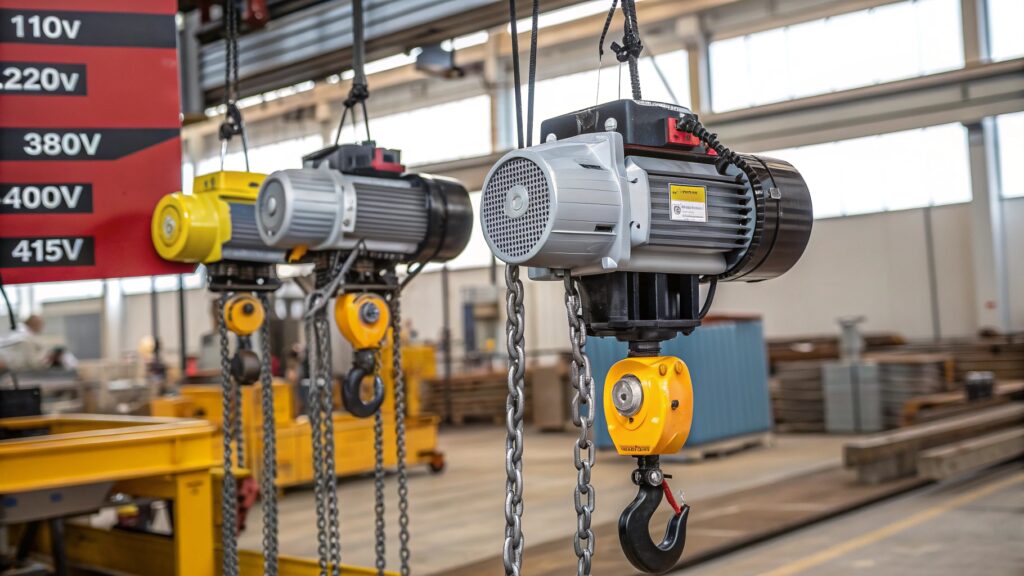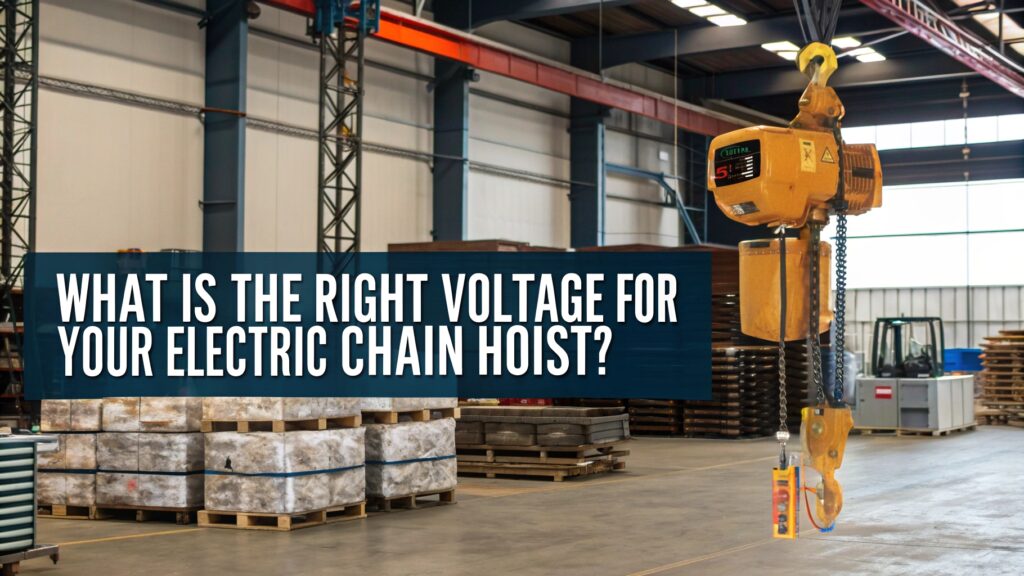Choosing the right voltage for your electric chain hoist is critical. If the voltage doesn’t match the hoist’s needs, you could face inefficiency, damage, or costly repairs. This guide will walk you through how to choose the right voltage for your hoist.
Electric chain hoists are available in various voltages, including 220V, 380V, 400V, 415V, and 440V, depending on the load capacity and application. For hoists lifting heavier loads (over 2.5 tons), a voltage of 230V or higher is recommended. Always verify the available power supply and ensure compatibility with your hoist’s specifications to avoid performance issues.
Choosing the wrong voltage can cause problems. I’ve seen cases where companies install a hoist with the wrong voltage, which led to slow operation or damaged machinery. Avoid this by understanding how to match voltage with your hoist’s specifications.
What Is the Voltage of Electric Hoists?
When looking for a hoist, the voltage is one of the most important specifications to check. But how do you know what voltage you need?
Electric hoists are available in different voltages: 110V, 220V, 380V, 400V, 415V, and 440V. The choice depends on the lifting capacity. For example, smaller hoists work with 110V or 220V, while larger hoists require 380V or higher for efficient operation.

Common Voltage Options:
| Voltage | Capacity Range | Use Case |
|---|---|---|
| 110V | Light-duty (up to 1 ton) | Residential, small workshops |
| 220V | Medium-duty (1 to 2.5 tons) | General industrial use |
| 380V | Heavy-duty (over 2.5 tons) | Large industrial environments |
| 400V | Heavy-duty (over 2.5 tons) | Used in high-capacity systems |
| 440V | Large industrial applications | Heavy lifting, high demand |
How to Choose the Right Voltage for Your Hoist
When selecting the voltage, consider your hoist’s load capacity and your facility’s power system. This is how you can make the right decision:
- Assess the Load Capacity: If your hoist is lifting heavier loads (2.5 tons or more), you’ll need 230V or 460V.
- Check Your Power Supply: Make sure your electrical system can support the voltage. If you have 220V or 380V supply, match the hoist voltage to the system.
- Work With the Manufacturer: The hoist manufacturer will give you the best advice on voltage compatibility. Always verify the recommendations before making the purchase.
Common Mistakes to Avoid When Selecting Voltage for Electric Hoists
Picking the wrong voltage for your electric hoist can lead to costly repairs or poor performance. Here are some common mistakes to avoid:
One mistake is choosing the wrong voltage for your hoist’s capacity. Another mistake is using voltage that’s incompatible with your facility’s power system.
Avoid These Pitfalls:
- Using Mismatched Voltages: Don’t use a 220V hoist with a 110V power supply. This mismatch can cause operational issues or permanent damage.
- Overestimating the Voltage Needed: Higher voltage doesn’t always mean better performance. Ensure the voltage fits both the hoist and your power supply.
- Ignoring Local Electrical Codes: Always check local codes to ensure your system complies with regulations and is safe to use.
Best Practices for Installing Your Electric Chain Hoist
Installing your hoist correctly is just as important as selecting the right voltage. Here are a few best practices to follow:
Proper installation ensures long-lasting and safe operation of your hoist.
Installation Tips:
- Hire a Licensed Electrician: Always let a qualified electrician handle the installation to ensure everything is wired correctly.
- Ensure Voltage Compatibility: Verify that the voltage of your hoist matches your facility’s power supply to prevent performance issues.
- Check Circuit Protection: Install the proper circuit protection, such as fuses or breakers, to safeguard against power surges.
What Is the Voltage of an Overhead Crane?
Overhead cranes are similar to electric hoists but have different voltage requirements based on their lifting capacity.
Most overhead cranes operate on 240V or 480V depending on their application and lifting capacity.
Overhead Crane Voltage Breakdown:
| Voltage | Typical Use | Capacity |
|---|---|---|
| 240V | Medium-duty overhead cranes | Small to medium |
| 480V | Heavy-duty cranes in large factories | Heavy lifting |
How to Work With Manufacturers to Get the Right Voltage Recommendations
The manufacturer is your best resource when selecting voltage for your hoist.
By communicating with the manufacturer, you can ensure you get the exact voltage recommendations based on your specific needs.
Tips for Working with Manufacturers:
- Provide Detailed Usage Information: The more details you give, the better the manufacturer can recommend the right voltage.
- Request Voltage Compatibility Charts: Some manufacturers provide charts that make it easier to match voltage to load capacity.
- Seek Post-Installation Support: Always follow up with the manufacturer for technical assistance if needed.
Conclusion
Selecting the right voltage for your hoist is crucial to its performance and longevity. By following these steps and working closely with the manufacturer, you can ensure safe and efficient operation of your hoist.



